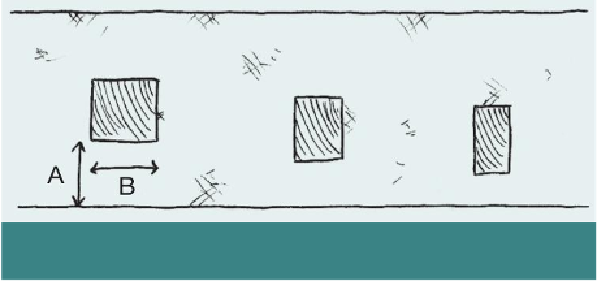Civil Engineering Reference
In-Depth Information
Figure 16.
The coverage of hempcrete over timber (A) should be greater than
or equal to the width of the timber (B).
There are no hard and fast rules to minimum coverage. Vicat have produced a coverage
chart for their binder, Prompt, but this is not an industry standard chart. As a rule of thumb,
all timbers or other structural elements should have at least 50mm covering of hempcrete,
and the covering should be at least as thick as the timber is wide (see
Figure 16
).
Externally, the minimum coverage is limited not only by the structural integrity of the
hempcrete but also by the risk of moisture ingress damaging the timber frame. During tests
that simulated severe driving rain on a hempcrete wall, a maximum water ingress of 70mm
was recorded:
Tests for water penetration were carried out by the BRE for the Haverhill
project on rendered hemp-lime walls 200mm thick. A rotary Spray appar-
atus was employed to apply water levels similar to one year's worth of wind-
driven rain at a severely exposed location, or five years elsewhere, over a
96-hour period, after which the absorption had reached a 50-70mm depth
… the test simulates a severe exposure and massive water application over
a short period with positive results.
1
Despite the fact that such weather conditions as simulated in this test are unlikely to occur,
and that in fair weather the moisture that enters a hempcrete wall very quickly dries to the
outside, this does suggest that any structural element should have a minimum of 70mm of
hempcrete cover towards the outside face of the wall. If 70mm cover cannot be achieved,
then a hardwood frame or external cladding may need to be considered. Hardwood is less
susceptible than softwood to damage from exposure to moisture, and as such should be
able to withstand the rare occasions of constant driving rain. Of course, if driving rain is a
regular feature on the proposed site, and this cannot be mitigated through the siting of the

Search WWH ::

Custom Search